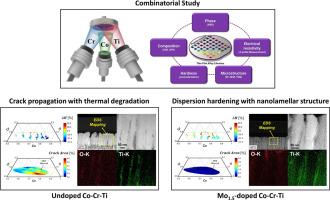Enhancing thermal stability and crack resistance in Co-Cr-Ti superalloy films through Mo doping: A combinatorial study
IF 9.3
1区 材料科学
Q1 MATERIALS SCIENCE, MULTIDISCIPLINARY
引用次数: 0
Abstract
In this study, we investigated the effects of 1.5 at.% Mo doping on the microstructure, hardness, and electrical resistivity of Co51∼86Cr9∼41Ti2∼11 thin-film alloys. Two batches of thin films were deposited, one at room temperature and the other at 600 °C, followed by annealing at 650 °C for 4 h to evaluate property changes after heat treatment. Without Mo doping, only lower Co content (less than ∼70 %) alloys exhibited significantly reduced annealing-induced cracking in both batches. With Mo doping, crack formation was found to be reduced or suppressed across all deposition conditions and compositions. Moreover, for room-temperature-deposited thin-film alloys with lower Co content, Mo doping facilitated the formation of an amorphous phase, which transformed into an amorphous-nanocrystalline composite upon annealing, achieving an exceptional hardness of 17.9 GPa. In films deposited at 600 °C with higher Co content (greater than ∼70 %), Mo doping stabilized nanolamellar structured precipitates, which helped mitigate thermal stress concentration by distributing it throughout the alloy matrix and eliminating observable cracks. These findings highlight the dual role of Mo in enhancing the mechanical properties and thermal stability of Co-Cr-Ti thin-film alloys, offering valuable insights for the design of high-performance superalloys.


Mo掺杂提高Co-Cr-Ti高温合金薄膜热稳定性和抗裂性能的组合研究
在本研究中,我们研究了1.5 at的影响。% Mo掺杂对Co51 ~ 86Cr9 ~ 41Ti2 ~ 11薄膜合金显微组织、硬度和电阻率的影响。将两批薄膜分别在室温和600℃下沉积,然后在650℃下退火4小时,以评估热处理后的性能变化。在未掺杂Mo的情况下,两批合金中只有Co含量较低(低于~ 70%)的合金表现出明显减少的退火诱导裂纹。在所有沉积条件和成分中,Mo的掺杂都能减少或抑制裂纹的形成。此外,对于Co含量较低的室温沉积薄膜合金,Mo掺杂促进了非晶相的形成,经退火后转变为非晶纳米晶复合材料,硬度达到17.9 GPa。在600°C沉积的高Co含量(大于~ 70%)的薄膜中,Mo掺杂稳定了纳米层状结构的析出物,通过将其分布在整个合金基体中并消除可观察到的裂纹,有助于减轻热应力集中。这些发现突出了Mo在提高Co-Cr-Ti薄膜合金的力学性能和热稳定性方面的双重作用,为高性能高温合金的设计提供了有价值的见解。
本文章由计算机程序翻译,如有差异,请以英文原文为准。
求助全文
约1分钟内获得全文
求助全文
来源期刊

Acta Materialia
工程技术-材料科学:综合
CiteScore
16.10
自引率
8.50%
发文量
801
审稿时长
53 days
期刊介绍:
Acta Materialia serves as a platform for publishing full-length, original papers and commissioned overviews that contribute to a profound understanding of the correlation between the processing, structure, and properties of inorganic materials. The journal seeks papers with high impact potential or those that significantly propel the field forward. The scope includes the atomic and molecular arrangements, chemical and electronic structures, and microstructure of materials, focusing on their mechanical or functional behavior across all length scales, including nanostructures.
 求助内容:
求助内容: 应助结果提醒方式:
应助结果提醒方式:


